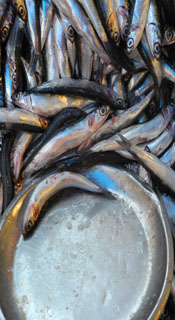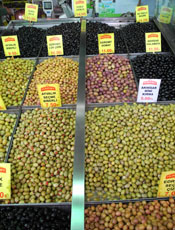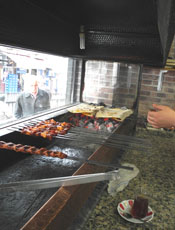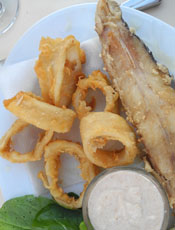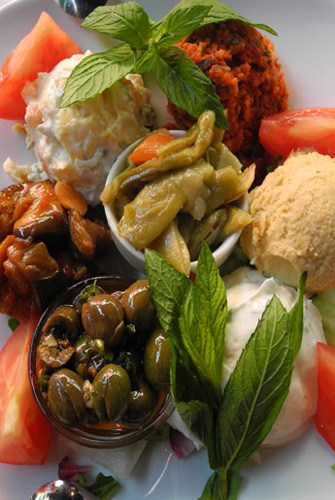A City Cook In Istanbul
It's long been my experience that people who love to cook also love to travel. And when we do, exploring the local cuisine of the places we visit becomes a big part of the adventure and the pleasure.
Some of my most vivid travel memories are from moments in foreign lands in which I connected with a culture because of what I ate. There was a large prawn, pulled from a roadside river in southern Malaysia, cooked by the man who caught it to make my lunch. A gulp of cold blood orange juice sold by a tiny woman and her son from a large-wheeled wooden cart that seemed to appear out of nowhere on a dusty road in Sicily, its sun-bright flavor enabling me to better feel the sweetness of this ancient, poor, and proud region. A breakfast of grilled tomato with a side of mushrooms, washed down with a cup of bracing tea, cut through my Austen-shaped romance with rural England to help me see its non-fiction charms.
Last month I was lucky enough to make more memories when my husband and I visited Istanbul for 16 days. We had spent two quick days there eleven years ago, at the end of a trip to Greece, barely time to dash through the Hagia Sophia and catch a plane home. But those two days haunted me and we finally were able to return to this exotic, ancient-yet-modern, and complicated city. It is home to 15 million residents who as easily if they were taking the 3 train to Times Square, routinely cross the Bosphorus, the body of water that links the Black Sea with the Sea of Marmara and the Aegean. Half of Istanbul is in Asia, the other in Europe and while it spent years trying to become part of the Euro Zone, Turkey now has relief instead of regrets as its independent economy thrives.
Istanbul is a palimpsest with a 3,000-year history marked by wars between Carthaginians, Greeks and Romans, centuries of empires controlled variously by Christians, Arab Muslims and Ottomans, and leaders whose names provoke our imaginations: Constantine, Suleiman, and Ataturk. A destination on the silk route and the spice route, today Istanbul is a striving, complicated, and vibrant city that remains a celebration of commerce. And of flavor.
Istanbul Eats
Turkey is a huge country. Larger than France or Spain, it's about the size of Texas and Oklahoma combined. It has regional subcultures, many with their own local ingredients and ways of cooking that have gradually become part of the national cuisine. Many books have been written about Turkish cooking and my 16-day immersion certainly didn't make me an expert. But I learned enough to take some risks and enjoy every meal, and enough to bring some of the Turkish kitchen home to mine.
To do this I got some help. On the advice of a friend who had recently been in Turkey, we signed up for a food walking tour with a company called Istanbul Eats.com, operated by Ansel Mullins and Yigal Schleifer who are also the authors of a guidebook by the same name. We signed up for two of their culinary tours: "Culinary Secrets of the Old City," which includes the Spice Market, confectionery shops, and some traditional Ottoman foods; and "Cosmopolitan Beyoglu," one of Istanbul's historic neighborhoods that today is the heart of the new, modern city.
Our guide for Beyoglu was Megan, an American from Vermont who is finishing her Ph.D. in linguistic anthropology and who ten years ago turned a one-day layover in Istanbul into a new life and home. Besides her warmth, enthusiasm, and charisma, Megan's ability to see the city and its cuisine as an outsider and an anthropologist, while also as a decade-long resident of an adopted city she loves, made her the perfect companion. She also loves to eat.
In the six hours we spent with Megan we were introduced to kaymak, a lightly sweet clotted cream made from water buffalo milk and served with bread and honey or on fruit. We learned how Balkan, Caucasian, and Middle Eastern foods add ingredients and flavors to traditional Turkish cooking and how the Turks can start a meal with pickled cabbage and carrots and end it with intensely sugared Turkish delight candies or pistachio baklava. And I discovered how little pieces of ground lamb and beef, when seasoned perfectly and grilled on a sword over glowing wood coals, and then wrapped in a thin bread that's been used to wipe the juices from the sword before it's filled with the cooked meat, tomatoes, sliced onions, and spices like ground sumac was so stunningly flavored that I declared it one of the three best things I had ever eaten in my life. Two days later I made my husband bring us back to have it again.
At the core of Megan's culinary lesson was a new word but a timeless concept: Usta. It means master craftsman. In Turkish cooking, Usta respectfully describes the man who since 1960 has stood every day in the midst of Beyoglu's fish market behind a pan of hot oil, frying mussels. Usta is the woman who makes small batches of simits, the bagel-like bread that's dipped in molasses-tinged water before baking so that the sesame-dusted crust gets crisp. Or the cook who every day makes a black cabbage soup, stewed chickpeas, and bulgur wrapped in white anchovies -- flavors from his home on the coast of the Black Sea. He, too, is an Usta.
Before our culinary walk, I had thought that Turkish cooking was primarily kebobs, salads, yogurt, and pilaf. While these are important aspects of the cuisine, in fact the flavors and craftsmanship are far more sophisticated and eclectic. I was very grateful that we met Megan early in our visit because it let me be more bold when exploring the flavors and more appreciative of those doing the cooking, many of whom are Ustas.
Putting Turkish Flavors Into A City Kitchen
Much of what I loved best about the food we had in Istanbul is difficult to put into our city kitchens. Like the wood coal-fired open ovens or the giant doners -- cones of slow roasted lamb or chicken that get sliced into sandwiches. What we'd call a gyro. But I learned that there are splendid Turkish dishes, spices, and ingredients that most city kitchens can easily adopt, no matter where you live.
Spices
Turkish food is flavorful and well seasoned but usually not very spicy. Nor is the food salty; if anything it's under-salted. But there are certain spices that show up in many dishes or are used as we would use salt and black pepper. The most common are:
- Urfa pepper. A mild, smoky pepper with a very subtle fruity flavor similar to Aleppo pepper. It has a flaky texture that is a little oily so that the flakes sometimes clump together. It's used in cooking but some homes and restaurants also have it on the table in a shaker as we'd use a pepper grinder, adding a little heat and complexity to a finished dish.
- Mint. Dried, crushed mint -- spearmint, not peppermint -- is used far more than fresh mint.
- Sumac. These little berries are crushed and ground into a coarse powder. Its tart, lemony, slightly sour flavor is added to meats, salads, and foods with yogurt sauces or dressings. I already had sumac in my spice collection and use it as a rub on skirt and hanger steak but now I will use it more.
Seasonings, Flavors, and Main Ingredients
- Aci Biber. A paste made from sweet and hot sundried peppers that is used in marinades, sauces, and as a condiment full-strength. It comes in two versions: aci, or hot, and sade or mild.
- Lemon juice. Used in salads as other cuisines use vinegar. When you order a salad in a restaurant, you'll usually also get a bottle of lemon juice along with one of olive oil to dress the salad yourself.
- Pine nuts. Turkish pine nuts are often added to pilafs, salads, and cooked dishes. Turkish pine nuts are usually long and thin and vastly superior to ones from China, which can have a bad metallic aftertaste.
- Pistachios. Used in desserts but also as a garnish on salads and cooked savory dishes.
- In-season fruits and vegetables, especially cucumbers, tomatoes, zucchini, black cabbage, carrots, watermelon, apricots, and cherries. They are often eaten fresh and either raw or simply cooked, but sometimes in an unexpected way, as when I had tiny meatballs cooked with sour cherries in a perfect sweet-sour combo.
- Dried legumes. Chickpeas, red lentils, and other beans are used in soups, stewed in tomato sauces, added to casseroles, and served as mezes, the little plates that often start a meal.
- Yogurt. Served at breakfast with dried fruit and honey, frequently used as the basis for a sauce, or as a meze when mixed with garlic and greens like purslane. See our recipe for Yogurt-Garlic Sauce that has only three ingredients: yogurt, garlic and salt.
- Pomegranates. When in season, this deep red fruit is a daily pleasure, especially as juice, but it's also used in savory cooking.
- Lamb. Turkey is a secular country but since 90% of its population is Muslim, pork is not eaten, making lamb the favored meat. It's cooked ground as kebobs or meatballs (called koftes), in chunks on a skewer, lamb chops, in soups, and in sandwiches.
- Rice and grains. These are cooked as pilafs with little bits of vermicelli, tomato, bitter greens, and legumes.
- Kaymak. This is the thick, slightly sweet cream, made from the milk of water buffalo, that we learned about on our culinary walk in Beyoglu. While kaymak isn't available in the U.S., you can make something like it with whole milk and heavy cream; we've added a link below to a terrific website called Binnur's Turkish Cooking that will show you how. Or you can sweeten store-bought crème fraiche, clotted cream, or mascarpone to similar effect. Kaymak is served at breakfast with bread and honey, or as a dessert with fresh or dried fruit, as in our recipe -- see our link.
One of the most popular dishes found on every restaurant menu is Shepherd's Salad, which is similar to what we know as a Greek salad, minus the olives and feta cheese, in that the ingredients are chopped and dressed just before serving. A classic Shepherd's Salad includes chopped tomatoes, cucumbers, spicy green peppers, and parsley and dressed with lemon juice and olive oil. See our recipe.
As much as I loved most of what I ate, there were a few things that either disappointed or didn't wow me. First, the bread. I was surprised that the most popular bread was white, soft and tasteless, much like our deservedly maligned Wonder Bread. Another more appealing bread is puffy, topped with Nigella seeds, and freshly made on a fire-cooked stone, which while tasty, needs to be eaten right after it's cooked.
I was also disappointed in the cheeses. The string cheeses that many Turks love for breakfast are very salty, although I loved their chewy texture. But the most popular is a white cheese, similar to feta but with a paler flavor, little personality, and an uninteresting texture.
And whoa -- all that sugar. Istanbul has confectionary shops, serving baklava, cookies, candies, and puddings, the way New York has bars and Starbucks. The tea is served with sugar. Turkish coffee is made with sugar already added -- you specify how much when you order the coffee, and Turkish delight candies are a serious habit. Maybe we should send Mayor Bloomberg over there to see what he could do about all that sweetness.
Finally, the ubiquitous simit, the Turkish pretzel-like bread sold by street vendors all day long as if it is Istanbul's official snack food, didn't make an impact on this bagel-loving New York City girl. It goes to show that sometimes travel is the best way to learn that there's no place like home.
